The Secret to Pitches That Nail It Every Time? Brevity. Investors stop listening when the pitch is just an avalanche of data.
By Brock Stechman Edited by Dan Bova
Opinions expressed by Entrepreneur contributors are their own.

Back when we first pitched our company DivvyHQ to investors, we thought we knew a lot more than we did: Our 45-minute presentation was jampacked with data. And our style was confident: We presented so frequently, in fact, that we could have pitched in our sleep. Our only change after approaching investor after investor, in Silicon Valley and around the country? We whittled down the length but kept the heart of our message intact.
Yet while our pitches generated great enthusiasm, no one cut us a check. So, we revised our presentation again. This time, we trimmed it to 15 minutes, but still kept all those compelling facts, figures, growth projections, competitive analysis and insights about our market opportunity. We remained convinced that our pitch was the best ones these investors had ever seen.
Oh, were we mistaken.
At the end of one presentation, an investor raised his hand and gave us, finally, the cold, hard truth. "Guys," he said, "I have no idea what you do. No clue." The murmurs of agreement throughout the room floored us. We had thought we were nailing it, but we hadn't even come close to landing a deal. Where had we gone wrong?
Pitching to the lizard brain
We quickly realized that we fundamentally misunderstood what constitutes a great pitch. Four days ahead of our subsequent meeting, our confidence shattered, we read Oren Klaff's Pitch Anything. The book explores the neuroscience of how people respond to sales presentations and opportunities. And reading it was the best thing we could have done because it transformed our outlook.
Humans are wired to assess situations as threatening or safe, a calculation Klaff says is made by what he calls our "crocodile brain." This is essentially the gatekeeper to more advanced, analytical thinking, Klaff explains: When a pitch doesn't inspire our listeners' confidence early on, their crocodile brains warn them off. No matter how positive their conscious response, they will not hand over money if their subconscious self warns them not to.
And hitting investors over their heads with stats about a company's reliability doesn't work, either. In fact, overwhelming the crocodile brain with charts and data right out of the gate is a surefire way to lose an investment.
Our success rate skyrocketed once we'd revamped our pitch strategy based on Klaff's principles and trimmed the pitch even more to a succinct nine minutes. Here's the approach we now take when presenting to investors. Other entrepreneurs can tweak it to their own needs and (hopefully) replicate our success:
1. Be brief.
We start our pitches with a 30-second introduction that covers who we are and just a couple bullet points why we're credible. Beyond that, the focus is on delivering a tight, concise presentation about our product. Investors' eyes glaze over when teams talk too much about themselves. Get to the point quickly.
Use clean, well-designed slides, and always be prepared with more in-depth financial projections and analytics in case they ask.
Related: How Star Wars Will Help You Raise Capital for Your Company
2. Address market forces.
After the introductions, Klaff suggests describing three key market forces or problems affecting your industry that are colliding. That gives investors context for why your particular product is innovative, necessary and timely.
3. Explain how you solve the problem.
Demonstrate how your product or service uniquely solves people's needs. Note gaps in the current market, and be specific when discussing opportunities. Investors look for a clear path to high-scale growth and how you'll become the clear market leader.
Related: The 'Shark Tank' Enjoys an Embarrassment of Riches: 4 Strong Proposals
4. Close with bulletproof stats.
We conclude our presentations with a rundown of key numbers that stick with investors. We use data to show the market opportunity, new client acquisition rate, user traction, the high-end clients we've signed, our projections and our plan to allocate funds to scale quickly. That's usually enough for investors to opt in. Remember that they're always asking, "Is this safe?" Make them confident that you have the expertise and pathway to success.
5. Read Pitch Anything.
Our pitch is structured on the format and flow of Klaff's system, and I can't recommend it enough. Klaff's understanding of the human brain allows startup teams to approach investors scientifically and hit all the right notes.
Entrepreneurs often think they need to create long, elaborate presentations to win investors' trust. But a short, fact-filled pitch that's optimized for how people actually respond to new information is the real key to securing investments.
Related: The 5 Best Pitch Tactics I Heard as an Angel Investor












